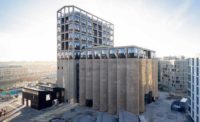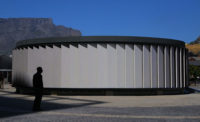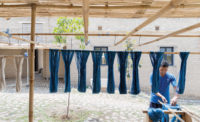British designer Thomas Heatherwick received no training as an architect—his degrees, from Manchester Polytechnic and the Royal Academy of Art, are in three-dimensional design. What to make, then, of his rapid scaling of the professional barricades and solid landing in the bastion of the global architectural elite? If the recently opened Zeitz Museum of Contemporary Art Africa (MoCAA) in Cape Town is our guide, there are multiple reasons to cheer the incursion. Inside, outside, Zeitz is stunning. Beauty is its own reward, but there’s more. This is one of the most important new public buildings anywhere, and surely one of the most significant in Africa.
Cape Town, routinely referred to as Africa’s most European city, has long drawn international tourists, and its V&A Waterfront, the historic harbor named after Queen Victoria and her son Alfred, is the city’s most visited destination. At one edge rises a nearly 200-foot-high grain elevator and silo that, when completed in 1924, stood as the tallest structure in Sub-Saharan Africa. It was decommissioned in the 1990s.
Additional Content:
Jump to credits & specifications
In South Africa, public space is a fraught, and somewhat neglected, terrain. Although apartheid was legally dismantled in 1994, the country continues to suffer the multiple distortions of its legacy. When the African National Congress (ANC) took over, all the country’s formal urban spaces, private and public, had been conceived, designed, constructed, and controlled by whites. Since then, the ANC has devoted itself to building housing to ameliorate the appalling slum conditions in the townships. New public space has not been a priority.
The exception is the transformation of Cape Town’s harbor. V&A Waterfront Authority officials recognized the grain elevator’s potential but struggled with ideas for how to use it, and turned to Heatherwick for help. Concurrently, Jochem Zeitz, a German collector of African art, working with Mark Coetzee, a curator native to Cape Town, sought a venue to house his growing collection of contemporary African art. An unlikely marriage was consummated. Heatherwick’s brief was reformulated into the problem of transforming this concatenation of historic, poured-in-place concrete structures–the 190-foot-tall cluster of 44 rectangular and square grain storage bins, the 108-foot-tall cluster of 42 cylindrical silos, and a small dust house—into a world-class museum. Aside from the 10 World Cup stadiums finished in 2010, this would be South Africa’s first major new public space in decades.
The exterior’s immensity and compositional clarity more or less guaranteed the project’s iconicity— there’s a reason Walter Gropius, Le Corbusier, and Charles Sheeler championed grain silos, with their stark, geometric purity, as towering incarnations of modernity—but Heatherwick refashioned this one into more than just a splendid exemplar of the type. Multiple layers of paint were removed, revealing the silos’ continuous surfaces—astonishingly, constructed in a single pour—which greatly amplifies their monumentality. Heatherwick—whose Learning Hub at Nanyang Technological University in Singapore demonstrates his understanding of the phenomenological allure of rich, variegated, textured surfaces—then polished and sealed the silos and elevators’ craggy, coarse-aggregate-filled concrete. To signal the structure’s programmatic transformation (in addition to an art museum, it contains a boutique hotel), he designed beautifully detailed, pillowlike windows. The faceted structural glazing changes color with the reflected light to make the Zeitz a beacon for miles around.
The exterior proved simple compared to the structural and programmatic conundrums of the interiors, which were critical to the museum’s sustained success. Just enticing visitors to actually enter the Zeitz was a central challenge, Heatherwick and Coetzee explain, as virtually no culture of museum-going exists in South Africa: people migrate to the redeveloped waterfront to shop, to dine, and to catch the ferry to Robben Island, not to partake of high culture—local or global, black or white.
“Theatricality should be inherent to pieces of public infrastructure” and civic landmarks, Heatherwick maintains, and his design for the main interiors of Zeitz MoCAA embodies theatricality in the best sense of the word: it tugs on your emotions, inspires a sense of delight. To do this, Heatherwick amped up his celebration of the building’s history. The narrow, vertical entrance foyer draws your gaze upward, where you discover, inset into the ceiling high above you, the original metal chutes that, when cranked open by hand, would pour the stored grains directly into large, open containers parked on train trestles. Immediately, an impression: this is an active place.
And then! Proceeding into the lobby opens up a jaw-dropping vaulted atrium—before, below, and above you—etched deep with shadows, streaming with sunlight. Reminiscent of Louis Kahn’s unbuilt, much smaller Mikveh Israel Synagogue project, this public atrium is as affecting as Frank Gehry’s Guggenheim Bilbao, a flat-out wondrous space, at once dynamic and containing, sensuously textural and gravely monumental.
Correctly determining that maintaining the existing building’s rigid geometries risked an overly static design, Heatherwick scanned a corn kernel to use as the datum for the shape of the atrium’s void, which is carved into the building’s clustered cylinders. The contrast between the void’s irregular, biomorphic curves and the concrete silos’ geometric regularity creates an extremely dynamic composition. (The 80 gallery spaces on nine floors, for a total of 65,000 square feet, are differently sized and proportioned white boxes. They function, they’re fine, and they’re nothing particularly special, but they are precisely what the curators demanded.)
The execution of this atrium proved more than complex. When the silos were originally constructed, the simple fact of their clustering created the building’s lateral stability. How to carve a long-span, multistory atrium out of such a structure? Working with engineers from Arup and local partner firms—Van der Merwe Miszewski Architects, Rick Brown Associates, and Jacobs Parker—Heatherwick’s team designed what is essentially a new building to support the original structure. Reinforced concrete “sleeves,” 9¾ inches thick, were poured inside each 18-foot-diameter cylinder. Then a land surveyor mapped hundreds of coordinates from the corn-kernel scans onto the silo bins, enabling contractors to identify where to scoop through the resulting two sandwiched layers of concrete.
This design produced opportunities for construction details that significantly enhance the building’s emotionally arresting quality. The sanded, velvety-smooth surfaces of the new structure highlight the burnished, jewel-like quality of historic concrete. Heatherwick is unapologetically after what he calls soulfulness, explaining that as a child “the public areas in cities always seemed to be their worst parts.” He credits his artistic training with helping get him to his current practice, adding that the curricula in architecture schools in the 1980s, when he was a design student, seemed “so abstracted from the everyday experience of people.”
Artist, architect, whatever: Heatherwick’s sensibility is a welcome addition to contemporary architectural discourse. Celebrate this accomplishment, watch what comes next, and keep an open mind.
CreditsArchitect: Heatherwick Studio
Personnel in architect's firm who should receive special credit: Mat Cash (Group Leader)
Associate architect(s): Van der Merwe Miszewski Architects, Rick Brown Associates, Jacobs Parker
Engineers Civil & Structural Engineer:Sutherland, Arup (London), Arup (Cape Town) Consultants Rational Fire Consultant: Arup (Leeds), Solution Station General contractor: WBHO
Photographer: Iwan Baan, Mark Williams |
SpecificationsStructural System Historic Structure: Combination of steel framee and reinforced concrete
Exterior Cladding Metal/glass curtain wall: Glazed Facades and Pillow Windows: Mazor Aluminum Moisture barrier: SIKA Sikalastic 152 to protect the historic concrete Roofing Other: Sculpture garden: concrete flat roof with raised precast pavers by World of Decorative Concrete and LJ LeRoux Doors Entrances: As Above Glazed Facades: Mazor Aluminum Metal doors: re-instated historic doors salvaged from original grain silo Wood doors: HG Holliday Fire-control doors, security grilles: HG Holliday Hardware Other special hardware: All above : Dorma Interior Finishes Acoustical ceilings: Vogl Acoustic Design Board Suspension grid: Saint Gobain Gyproc Demountable partitions: Saint Gobain Gyproc Cabinetwork and custom woodwork: Libra Joiners an HG Holliday Paints and stains: Akzo Nobel Dulux Special surfacing: Polyurethane gallery floors – SIKA Comfort Floor Tough Floor and wall tile: Refin (Floor) and Ceramica Vogue (Wall) Carpet: NEXUS Westminster Lighting Interior ambient lighting: Province Lighting and Philips. Conveyance Elevators/escalators: Schindler Lifts Plumbing Sanitaryware – Bocci Energy Other unique products that contribute to sustainability: District Cooling |
















Post a comment to this article
Report Abusive Comment